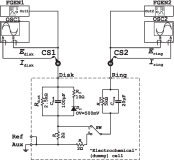
Dual cyclic voltammetry with rotating ring–disk electrodes
The paper authored by
S. Vesztergom,
M. Ujvári and
G.G. Láng
is published in Electrochimica Acta (2013, vol. 110, pp. 49–55).
Abstract:
The simultaneous perturbation of the disk and ring electrode potentials of an RRDE with time-varying controlling waveforms seems to be an effective way of carrying out high-sensitivity collection experiments. The method of dual cyclic voltammetry (i.e. applying dynamic potential programs to the disk and the ring electrodes of an RRDE simultaneously) has proven to be an especially promising method for studying the mechanisms of electrochemical processes. The new 3D representation of the data can be effectively used in order to reveal the formation of electroactive species in the disk electrode process. However, some issues concerning the application of this method may also arise. The “dual dynamic” perturbation of the electrodes can cause transients to appear in the current–potential characteristics of the two electrodes, which often results in electrical cross-talk effects. In this paper it is shown that the afore-mentioned cross-talk (experienced mainly when perturbations of a high rate are applied) is caused by the common resistance shared by the current paths of the two working electrodes. Numerical simulations as well as experiments with a simple model system have been carried out in order to study the cross-talk effects, and a method is suggested for their elimination.
